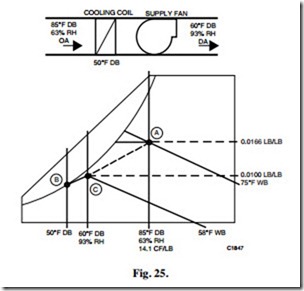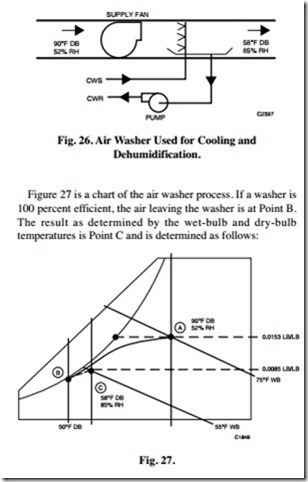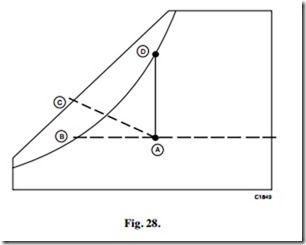COOLING AND DEHUMIDIFICATION
BASIC PROCESS
Cooling and dehumidification can be accomplished in a single process. The process line moves in a decreasing direction across both the dry-bulb temperature lines and the constant moisture lines. This involves both sensible and latent cooling.
Figure 12 illustrates cooling air by removing sensible heat only. In that illustration, the resulting cooled air was 95 percent relative humidity, a condition which often calls for reheat (see DEHUMIDIFICATION AND REHEAT). Figure 25 illustrates a combination of sensible and latent cooling. Whenever the surface temperature of the cooling device (Point B), such as a chilled water coil, is colder than the dew point temperature of the entering air (Point A), moisture is removed from the air contacting the cold surface. If the coil is 100 percent efficient, all entering air contacts the coil and leaving air is the same temperature as the surface of the coil.
All coils, however, are not 100 percent efficient and all air does not come in contact with the coil surface or fins. As a result, the temperature of the air leaving the coil (Point C) is somewhere between the coolest fin temperature (Point B) and the entering outdoor air temperature (Point A). To determine this exact point requires measuring the dry-bulb and wet-bulb temperatures of the leaving air.
To remove moisture, some air must be cooled below its dew point. By determining the wet-bulb and the dry-bulb temperatures of the leaving air, the total moisture removed per pound of dry air can be read on the humidity ratio scale and is determined as follows:
1. The entering air condition is 85F dry bulb and 63 percent rh (Point A). The moisture content is 0.0166 pounds of moisture per pound of dry air.
2. The leaving air condition is 60F dry bulb and 93 percent rh (Point C). The moisture content is 0.0100 pounds of moisture per pound of dry air.
3. The moisture removed is:
0.0166 – 0.0100 = 0.0066 pounds of moisture per pound of dry air
The volume of air per pound at 85F dry bulb and 75F wet bulb (Point A) is 14.1 cubic feet per pound of dry air. If 5000 cubic feet of air per minute passes through the coil, the weight of the air is as follows:
5000 + 14.1 = 355 pounds per minute
The pounds of water removed is as follows:
355 x 0.0066 = 2.34 pounds per minute or
2.34 x 60 minutes = 140.4 pounds per hour
Since one gallon of water weighs 8.34 pounds, the moisture to be removed is as follows:
140.4 + 8.34 = 16.8 gallons per hour
AIR WASHERS
Air washers are devices that spray water into the air within a duct. They are used for cooling and dehumidification or for humidification only as discussed in the HUMIDIFYING PROCESS—AIR WASHERS section. Figure 26 illustrates an air washer system used for cooling and dehumidification. The chiller maintains the washer water to be sprayed at a constant 50F. This allows the chilled water from the washer to condense water vapor from the warmer entering air as it falls into the pan. As a result, more water returns from the washer than has been delivered because the temperature of the chilled water is lower than the dew point (saturation temperature) of the air. The efficiency of the washer is determined by the number and effectiveness of the spray nozzles used and the speed at which the air flows through the system. The longer the air is in contact with the water spray, the more moisture the spray condenses from the air.
1. The entering condition air is 90F dry bulb and 52 percent rh (Point A). The moisture content is 0.0153 pounds of moisture per pound of dry air.
2. Air that contacts the spray droplets follows the saturation curve to the spray temperature, 50F dry bulb (Point B), and then mixes with air that did not come in contact with the spray droplets resulting in the average condition at Point C.
3. The leaving air is at 58F dry bulb and 85 percent rh (Point C). The moisture content is 0.0085 pounds of moisture per pound of dry air.
4. The moisture removed is:
0.0153 – 0.0085 = 0.068 pounds of moisture per pound of dry air
Figure 28 summarizes the process lines for applications using washers for humidification or dehumidification. When the water recirculates, the process is adiabatic and the process line follows the Constant Enthalpy Line A-C. The water assumes the wet-bulb temperature of the air as the process line extends. Note that whenever the washer water temperature is between the dew point (Point B) and the dry-bulb (Point D) temperature of the air, moisture is added and the dry-bulb temperature of the air falls. If the water temperature is above the dry-bulb temperature of the air (to the right of Point D), both the air moisture and the dry-bulb temperature increase. Whenever the water temperature is below the dew point temperature (Point B), dehumidification occurs as well as dry-bulb cooling. This process always falls on a curved line between the initial temperature of the air and the point on the saturation curve representing the water temperature. The exact leaving air temperature depends upon the construction and characteristics of the washer.
Related posts:
Incoming search terms:
- cooling and dehumidification psychrometric chart
- cooling and dehumidification
- psychrometri dehumidification curve
- psychometric chart air washer
- psikometric chart cooling
- chart of dehumidification
- psychometric chart showing dehumidification and cool
- psychometry skeletal chart cooling and dehumidification
- psychrometric chart for dehumidification
- is during cooling and dehumidification dry bulb temprature is
- dehumidification chart
- cooling and dehumidifying
- cooling and dehu
- cooling and de humidification
- Cooling & Dehumidification
- coolind and duhumdification#scso=uid_WPdmKAAIWKUKjzYHFw305Q_6:600
- chilled water tempreture psychrometric chart uk
- psychrometric chart leaving air temp


